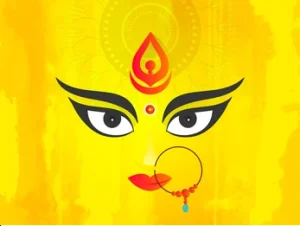In My Meditation Today. This is less meditation and more contemplation. The stories we tell our children ( or the television shows or movies we watch with them) are more than “fun” activities. The stories we select, the characters we like, and the commentary we provide as part of these rituals are codes. The codes tell them what we like and do not; what makes us happy and sad; what we are comfortable with and what makes us nervous; what our expectations are, and what disappoints us. Whether it is sexism, racism, homophobia, or Islamophobia, we do not have to teach our children prejudice and or shame explicitly. It is all learned through osmosis.
The Grand Story of the Divine Mother is told in three parts. Each describes a battle between good and evil, and most often, the story is interpreted as the forces of good and evil external to us.
However, a more helpful interpretation for me is that it represents the battle between my basest instincts and my highest potential. The battles are bloody and gory because a battle to live from your highest potential is hard, ugly, and metaphorically bloody and gory.
The eighth chapter of the myth is the third in the last section of the Grand Story of the Divine Mother. I am devoting two posts to it because there are two distinct aspects I want to explore. In this post, I examine the surprisingly feminist slant of this myth, written almost 1500 years ago.
In this chapter, Shumbha & Nishumbha’s battle with Devi continues. Despite her victory over Dhumralochana, Chanda & Munda, Shumbha & Nishumbha refuse to admit their powerlessness. They continue to send in larger and larger armies to try to capture her. It is almost as if Devi is enticing deeper, more powerful demonic forces to battle her.
Can you see how this could be the description of a spiritual journey? As one steps onto the path and expresses a willingness to do the work, more and more of our hidden inadequacies and fears rise to the surface to be acknowledged and accepted, and brought into the fold.
It is essential to understand that in Hindu Mythology, it is a blessing to be killed by the Divine Mother (or any divine entity), as it ensures that your energy becomes one with hers. Thus there is no rejection or destruction. There is instead a welcoming into all that is.
As Shumbha & Nishumbha send in their most enormous army yet, Devi summons reinforcements. She calls forth seven energies from Hindu “Male “ deities Brahma, Vishnu, Shiva, Indra, and Kumara. Three from Vishnu ( Vaishnavi, Varahi, & Narasimhi), Brahmani from Brahma, Maheshwari from Shiva, Aindri from Indra, and Kaumari from Kumara.
Each goddess is equipped with weapons associated with her particular male counterparts.
Although the weapon’s actual shape or name may differ, each one is a tool to help the aspirant go from ignorance to actual knowledge. For instance, Brahmani carries a pot of water, and her role on the battlefield is to sprinkle it on the demons. The water – knowledge- releases them from ignorance.

In his book “Encountering The Goddess,” Tom Coburn describes how the myth emphasizes the Goddess’s supremacy over the “male” deities whose power she summoned. The powers Devi calls forth from the gods are powers she has instilled in them. That she is the source of all of creation is re-emphasized in chapter nine, just before her epic battle with Shumbha.
The fact that the army that is about to fight the vast array of male demons consists of just seven Goddesses that Devi summons and herself is not the only exquisitely feminist angle in this chapter.
After she has prepared her army and is about to go into battle, seemingly out of nowhere, her husband Shiva comes to her and says, “ Let the asuras be slain quickly for my satisfaction.” Devi, who has managed the entire battle so far, is not about to meekly accept Shiva’s command.
As Shiva finishes speaking, much like in the last chapter, a terrifying version of her emerges and says to Shiva, “ You, yourself, become my messenger to Shumbha & Nishumbha and tell them to go to the netherworlds or let my jackals feast on their flesh.”
She does not give a quarter, puts Shiva in his place, and earns the name “ Shivaduti” – she who has Shiva as her messenger.
These powerful images show female mythological characters who are entirely at ease with their power and care little about how they appear to the world, and I had never heard of them as a young girl.
It is also a fact that I could not find an image of the Devi directing Shiva to be her emissary, but I did find a picture of Shiva directing the Devi to kill the asuras :).
There were many strong women role models in my life, but not a single one was comfortable with, or even wanted to be seen as, a POWERFUL woman. I sensed how nervous men, and especially women around me, were even thinking about powerful independent women. I learned through osmosis that it was unsafe to be a powerful female.
Patriarchy is powerful
I have largely overcome that legacy, or a lot of it. I wish that the generations after me could get to where I am with less pain and more speed.
Perhaps one way to do that is to examine the stories we are telling young girls and boys and become aware of the covert agenda inherent in our choices.
